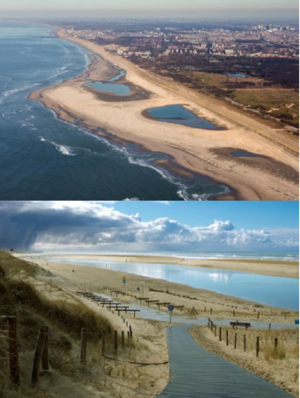C-SCAPE- Sandy strategies for sustainable coastal climate change adaptation
The narrow strip of beach and dunes form an important part of the coastal protection system around the world. Even though it only makes up about 4% of the earths total landmass. They protect the hinterland from flooding, provide freshwater filtration and storage services and add unique wetlands and landscapes which provide many touristic and recreational functions. However, these areas are experiencing heavier erosion each year. Therefore, innovative measures created by the Building with Nature and Living Shorelines philosophies will be put to use in order to halt and reverse ongoing erosion.
The solution proposed is the addition of sand suppletions to areas that show high erosion rates. The volume of the nourishments is determined by predicting the erosion rate on current knowledge gained by monitoring. Two large-scale nourishment projects have been created (Sandmotor and Hondsbossche Dunes) and form the living labs for the project C-SCAPE. Examining natural and anthropogenic drivers of the coastal landscape is the key to high quality data on erosion and effectiveness of the sand suppletions. On the two locations not only physical experiments will be done, but also societal factors will be taken into account.
The objective of C-SCAPE is to develop the knowledge and tools needed to assess the feasibility and benefits of sandy strategies for coastal climate adaptation.
Research type: field research, desk analysis, lab research
Location: Sandmotor Delfland and Hondsbossche Dunes
Contact: Joost Stronkhorst

